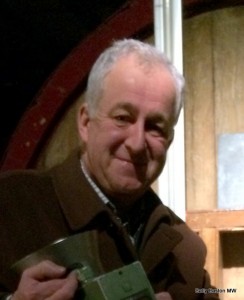The cheeky boys
I couldn’t resist the weak English pun. Champagne Jacquesson is owned by the Chiquet brothers. I only met one brother, Jean-Hervé, and he was disarmingly charming and had a mischievous glint in his eye.
Onto the serious stuff – these wines are proper tasty.
We can take the easy road and just try the wine. The name of their non-vintage cuvee is a three digit number that starts with 7xx. The current cuvee is 738. It moves up one every year.
… Or we can take the long road (read) to find out why the Chiquet brothers stand among giants of Champagne … and why their label changes every year.
Jean-Hervé and his brother Laurent took over the family business in 1988. At this time Champagne Jacquesson was a classic champagne house, owning 15 hectares and having contracts on another 30 hectares, making 450,000 bottles.
Since then, the brother have turned the business into something very different. Jean-Hervé said “today we have 28ha, with contracts on only 8ha, and we make 260,000 bottles. We dropped production by 40% to make the best wine we can.” He added “we buy only from our neighbours, and we do the picking and pressing ourselves, which is key.” Thus they have moved from a classic house to more of a grower champagne philosophy. And their vineyards are all premier and grand crus.
The brothers effectively make one wine per year. Jean-Hervé said “91 to 100% of our production is one wine. From time to time, we subtract some wine to make some single vineyard wine”. This one wine – the 700 series cuvee – is not a vintage because the brothers use reserve wines. Indeed they have eight years worth of reserve wines. But their wine is based on a single vintage. They want to blend the best they can, without dominating the vintage character. Which is why the number goes up one each year.
Such a philosophy turns on its head the traditional view of Champagne as a blend of many vintages which allows the irregularities of vintage quality and quantity to be smoothed. This traditional cross-vintage blending also allowing the best conditions for houses to maintain a house style from year to year in an otherwise, cool, rather unpredictable climate.
The Chiquet brothers change of approach started nearly 20 years ago when they were working on their (previous style) non vintage. Jean-Hervé said “we found the blend was very chardonnay-orientated. We made a second blend. Then one day we were talking about that … we had deliberately decided to make a wine that was less good.
“We started to reverse our way of thinking. When we blended, instead of trying to imitate last year, we tried to make the best blend every year.” This way, they found their blend was better. And different each year. This blend forms the foundation of the 7xx cuvee. Reserve wines are included “for the added complexity. We add enough to increase complexity without hiding the vintage.”
Part of the thinking of making their best blend possible each year has included stopping making a vintage wine, though, said Jean-Hervé “only in 2020 will all the ‘old’ wines be gone.” Given that the brothers started in 1988, that’s quite an evolution.
Having said Jacquesson only make the one cuvee (apart from occasional single vineyard vintages), they do. But they also keep a portion of this cuvee and age it for five more years. It then becomes “7xx, dégorgement tardif”, late disgorged. The first dégorgement tardif was 733.
And why 7-series? Jean-Hervé explained it was a technical number from their cellar for the different wines. Cuvee no. 1 had been made in 1898 to celebrate the company’s hundredth anniversary. He said “700 wines over 100 years. 728 [the brothers first in the new guise] was the 728th cuvee since then.” Based on the 2000 vintage.
Vinification is mostly in large oak; malolactic fermentation is not blocked; base wines are kept on lees for a year before the tirage bottling. Dosage is minimal – typically wines are ‘extra brut’.
How to remember which 7 series is based on which vintage … do a little maths … ?
- 738 is based on 2010 vintage – subtract 28 and ignore the 7
- Or add 1272…
- Or memorise 738 and 2010, and work from there.
Wine tasting, in situ, February 2016
The imprint is serious, dry, creamy textured with complex primary and savoury flavours.
Champagne Jacquesson, Cuvée 738, Extra brut
Based on 2010. 61% chardonnay, 28% pinot noir, 21% pinot meunier; 33% reserve; 2.5g/l RS.
Creamy, dogwood, hawthorn, nutty and floral nose, creamy palate attack, fine bubble, white flowers, and creamy white nuts. Really complex and layered, with toast and fresh bread. Big flavour without being big. Harmonious. Silky texture. Long finish.
Champagne Jacquesson, Cuvée 739, Extra Brut
Based on 2011. 57% chardonnay, 21% pinot noir, 22% pinot meunier; 31% reserve; 3.5g/l RS.
Rounded attack, fuller somehow, bit more savoury; brioche, smoked strawberry thing going on, rich and layered. Broader, richer, these things are relative.
Champagne Jacquesson, Cuvée 734 dégorgement tardif, Extra Brut
Based on 2006. 54% chardonnay, 20% pinot noir, 26% pinot meunier; 27% reserve; 3.5g/l RS. Disgorged in 2014, plus one year of post disgorgement rest. Deep lemon, creamy, just beginning of caramelisation, confit citrus fruits, tropical notes, butterscotch, fine, fine mousse. Freshness, fineness of texture and huge intensity. Simply delicious.
My visit to Champagne was sponsored by the CIVC (Comité Champagne).




